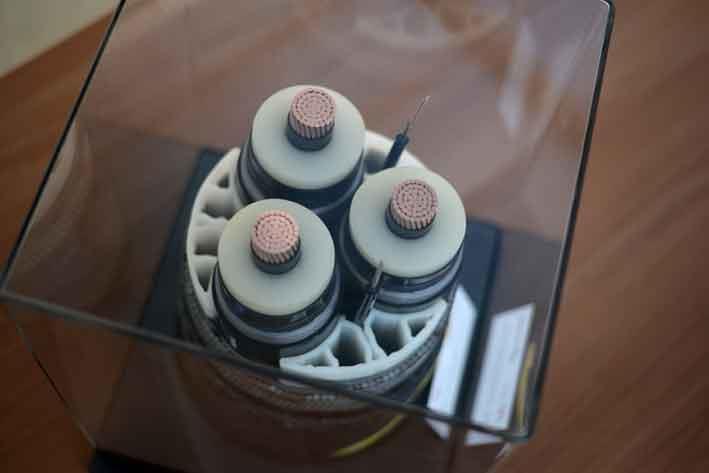The electricity interconnector linking Malta to the European energy grid via Sicily was officially inaugurated this evening by two Prime Ministers, Malta's Joseph Muscat and Italy's Matteo Renzi.
The project was initiated by the previous government - former Prime Minister Lawrence Gonzi was invited to the inauguration - and in his address, Dr Muscat took care to pay tribute to his predecessor, stating that he had embarked on an ambitious project which likely faced a lot of resistance, not least because of the significant expense involved.
"He had a choice to make, and he made the right call," he maintained.

A contract with Norway-based cable-laying company Nexans was signed in December 2010, and initial forecasts suggested that the project, which is part-financed through the EU's European Energy Programme for Recovery, would have been concluded by the end of 2013.
But faced a number of delays, including in the issuing of the necessary permit to lay the undersea cable from Sicily, where the project attracted opposition from environmental groups.
The project was finally approved by Italy in January 2013 after Malta agreed to pay €600,000 in environmental compensation. The necessary authorisations to construct the required installations at Marina di Ragusa, where the undersea cable starts, were secured last summer.

Dr Renzi himself acknowledged that Italian bureaucracy was not easy to navigate through, whilst Dr Muscat thanked him and his predecessor Enrico Letta for helping cut through it.
All equipment installation and cable jointing works in Malta and in Sicily were completed by the end of December 2014, and the main testing of the system began last January, paving the way for its commissioning today.

What the project consists of
The interconnector is a 120km-long high-voltage alternating current system capable of transmitting up to 200MW of electrical power in either direction, thus providing Malta the opportunity both to purchase electricity from Europe as well as potentially sell excess capacity.
It is linked to the Italian - and as a result, European - energy network at the Terna substation at the southern Italian city of Ragusa, and travels 19.1km over land before reaching the Mediterranean Sea at Ragusa's coastal suburb of Marina di Ragusa.
Its subsea circuit is approximately 98km long, and was laid between December 2013 and March 2014 using a specialised cable-laying vessel, the Nexans Skagerrak. The submarine cable is buried in a trench beneath the seabed along most of the route, but in areas where the seabed was too hard to excavate, the cable is covered with a rock berm.

The cable also crosses some Posidonia oceanica meadows, and in these areas, to avoid damaging the plant's habitat, the cable has not been buried or entrenched but wrapped in strong cast iron shells.
The interconnector makes landfall at Qalet Marku in Baħar iċ-Ċagħaq, and is then linked to Enemalta's Magħtab terminal a short distance away.
At the terminal station, electricity from the submarine cable - which is to be received at 220kV - is stepped down to 132kV, and fed to the Maltese grid via cables which pas through a 6.5km underground tunnel leading to the Kappara distribution centre.
Besides electricity copper power cables, the interconnector also includes two fibre optic clusters, and Enemalta is set to use this capacity to transmit the data required in the operation of the interconnector's monitoring, protection and control systems.

PM maintains more interconnections are ahead
In his address, Dr Muscat also emphasised that the government aims to embark on more energy interconnectors in the future, as part of its bid to transform Malta into an energy hub.
The first step, the Prime Minister said, would be a gas pipeline linking Malta to Italy, on which preliminary studies were at a "very advanced stage." But he added that once the political situation in North Africa stabilised, Malta would also seek to develop similar connections with its southern neighbours.
He said that it was important that Europe does not only become more interconnected internally, but also better connected with the rest of the world, stating that such connections reduced dependencies which came at an economic, social and even political cost.

On their part, both Dr Renzi and Malta's Energy Minister Konrad Mizzi emphasised that the importance of the project went beyond its own merits, describing it as the starting point of further collaboration between Malta and Italy.
Dr Mizzi insisted that the project was not simply an engineering achievement, but also a true collaboration between neighbours and a testament to a long-lasting bilateral relationship between the two countries.
He said that the project was only the beginning of a "journey of collaboration" on energy between Malta and Italy, which, he said, would hopefully lead to the implementation of a Euro-Mediterranean gas platform and to the development of a future gas interconnector between the two countries.
The Italian Prime Minister said that the choice to develop an interconnector was not simply technical, but also cultural, stating that at a time in which many saw the Mediterranean as a sea characterised by conflict and division, building bridges was important.
Dr Muscat expressed similar sentiments, stating that such projects showed that the Mediterranean could be transformed from a "sea of tragedy" to a sea of opportunity and hope.
Photos Jonathan Borg